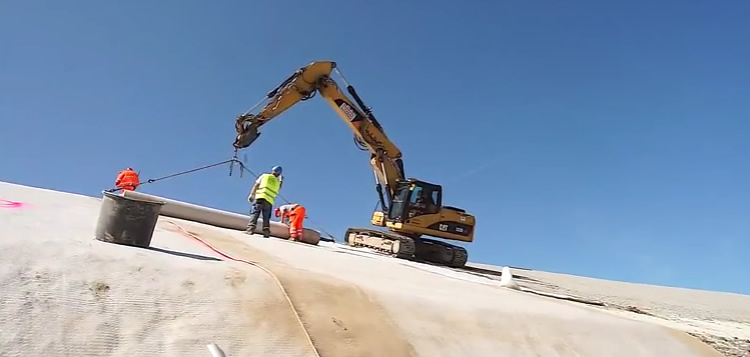By NAUE – After more than 50 years of operation, the Hohenwarte II pumped storage facility near Saalfeld/Thuringia had seen many changes both in the ways in which the facility needed to be used and in its infrastructure and performance. Numerous changes had occurred to the site’s inlets and outlets. The pumped storage facility began to exhibit high rates of leakage.
The issue was the aging, inclined mineral seal, which was covered by a filter layer and a stone deck. That old barrier was in need of rehabilitation. Site operators opted to update the 15,000m² barrier zone with a more controllable, engineered geosynthetic system.

PUMPED STORAGE FACILITY SOLUTION
The rehabilitation works were implemented in several steps.
First, the cover and the filter layers were removed. The existing surface of the mineral seal was then prepared. The old mineral seal was turned up, portions were removed, and the site was level led. Post-compaction works followed and a thin layer of sand was applied to better support and protect the forthcoming geosynthetic components.
In the next step, a tie-in drainage channel was added to the mineral seal, an anchor trench was set at the dam crown, and drainage prisms were created. Piping was installed in the prisms and Secudrain® 131 C WD 401 131 C drainage mats were placed from crown to prism.
Bentofix® NSP 10300 a geosynthetic clay liner (GCL) was installed upward on the slope and atop the drainage mats, from the drainage channel to the anchor trench.

The tie-in trench was filled with high-quality clay and compacted. The Bentofix® NSP 10300 a, with its 50cm bentonite impregnated edge, provided a self-sealing overlap zone for enhanced barrier performance. Each roll of GCL was produced in such a way that it could be installed without transverse joints. Bentofix® panel installation took place in the months of August and September, with an average installation rate of more than 1,000m² seal accomplished per day.

A 30cm-thick sand protection layer was installed atop the GCL, followed by a 20cm thick protection and filter layer made of old filter material.
Stone revetment was then constructed as the top layer for the pumped storage facility.
The construction sequencing and the materials used created a consistent, controlled, high-quality barrier. The geosynthetic system extended 600m in length (approx. 8m below the crown). The slope angle was 1:2.8.
The geosynthetics selected for the site enabled a consistent seal quality and efficient installation — without interfering with the existing dam geometry. Additionally, geosynthetics saved the site from what would have been a costly, labor-intensive 50cm-thick mineral seal installation. By avoiding that, the site saved on construction time and material costs and transport. The geosynthetic seal costs less and was installed far quicker, while simultaneously providing more dependable, long-term performance.
Because the pump storage operation places stress on the barrier system, quality assurance in the construction was of high importance. The strict quality system associated with landfill construction governed the site works.
A GCL installation specialty company (ENIG GmbH) contributed to the project. Local construction supervision and an additional expert were also present at all times.
With these experienced professionals on site, compliance with Bentofix® installation instructions was assured from delivery to temporary storage to installation and cover placement. Numerous samples were taken to ensure compliance with the characteristic values. Since the basin was commissioned again in October 2015, only a small amount of measurable leachate has been detected, and that was in the area of a gasket, which can be controlled with geosynthetics.
All project parameters and targets were exceeded.
NAUE documented the project with a video featuring interviews from key engineering and pumped storage facility personnel.
Learn more about NAUE’s geosynthetics and applications expertise at www.naue.com.
**
A version of this story first appeared in NAUE News 46.











